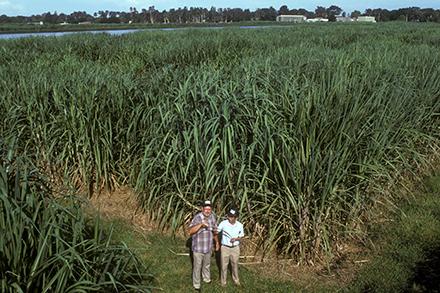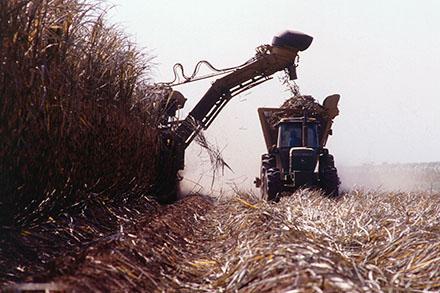New Cultivars Sweeten Sugar Industry
Bananas Foster, beignets, pralines, king cake. On top of their connection to New Orleans, these dessert classics have one thing common: sugar. And as it turns out, sugar's origins are just as wild as you might expect for a plant that grows in the land of Mardi Gras. Sugarcane, the most famous source of sugar, is related to a weedy grass.
Louisiana is unique among sugarcane-producing areas because its sweet "weeds" come from more than one species. Breeders use these wild relatives in their breeding programs to locate and pass on their beneficial traits. HoCP14-885, the newest sugarcane variety from scientists at the Agricultural Research Service's (ARS) Sugarcane Research unit in Houma, LA, features disease-resistance, the ability to withstand freezing temperatures, and greater sugar content.
Anna Hale, ARS plant geneticist in Houma, likened the breeding process to weed growth in one's backyard.
"We would like our cane to grow with little input, like fertilizer," she said. "Sugarcane's weedy relatives were able to survive on their own without pesticides and fungicides and they kept on going. Since they could do this, they must have genes for resistance, cold tolerance, etc. We want to tap into these genes and bring them into our new cane."
HoCP14-885 combines several traits from wild relatives to make it early-maturing, extremely sweet, and able to maintain high yield even after multiple harvests. Hale said that HoCP14-885's yields are better than any variety previously released in Louisiana.
The economic sustainability of the domestic sugarcane industry is dependent on the continued release of well-adapted, high-yielding varieties, Hale said. The quality of Louisiana's sugarcane allows the industry to produce sugar in half of the time it takes many other countries.
"The longer a variety is in the field, the more time diseases and pests have to adapt and overcome the plant's defenses," she explained. "This means that varieties of sugarcane tend to be successful for a limited amount of time. Without the systematic integration of characteristics like cold tolerance and disease resistance of these wild plants into commercial varieties, the Louisiana sugarcane industry would not be here today. The release of HoCP 14-885 demonstrates the success, not only of our commercial breeding program, but also of our ability to use wild and weedy plants to our benefit."

Sugarcane breeding efforts and agronomic studies focus on developing varieties with high biomass yield and increased cold tolerance, which would also allow for a longer harvest season. (Photo by Scott Bauer)
Hale is quick to point out that the ARS Sugarcane Variety Development Program uses painstaking, traditional breeding methods that take about 13 years to produce industry-ready commercial varieties. It has operated under an agreement with its partners, the American Sugar Cane League of the USA, Inc., and the Louisiana State University AgCenter.
Historically, the use of wild species has saved the Louisiana industry many times and has been a part of breeding in Houma since the beginning. In the early 1900s and again in the 1950s, mosaic disease caused rapid yield declines in Louisiana. The sugar industry was on the verge of collapse but was rescued by resistance derived from the weedy relative.
"The key to the success of this work has been that basic breeding is part of our program and not a limited-time project," Hale said.
Sugarcane is big business in Louisiana; the crop is grown on 480,000 acres, employs 19,000 people, and has an annual value of over $2.3 billion. ARS is integral to the industry's success and a new cane variety may take things to the next level.
Sugarcane breeders from other regions may also access genetic information from Louisiana's wild sugarcane species because ARS maintains the World Sugarcane and Related Grasses Collection at the ARS Genebank Repository in Miami, FL.
"The ARS legacy of plant collecting, characterization, and conservation has been critical to ARS sugarcane breeding and U.S. production," said Tim Rinehart, ARS national program leader for specialty crops in Beltsville, MD.
"In a sense, Louisiana sugarcane breeding is a 'rags to riches' story because all of its varieties have weeds as ancestors," Hale said. – By Scott Elliott, ARS Office of Communications
You May Also Like:


